Tamsui District
Tamsui District[1][2][3][4] (Hokkien POJ: Tām-chúi; Hokkien Tâi-lô: Tām-tsuí; Mandarin Pinyin: Dànshuǐ) is a sea-side district in New Taipei, Taiwan, Republic of China. It is named after the Tamsui River; the name means "fresh water". The town is popular as a site for viewing the sun setting into the Taiwan Strait. Though modest in size (population 162,441), it has a large role in Taiwanese culture.
Tamsui 淡水區 Danshuei, Tanshui, Danshui | |
|---|---|
District | |
| Tamsui District | |
 Waterfront at sunset | |
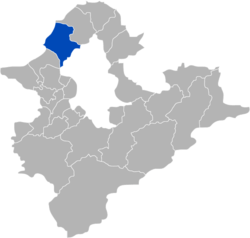 Tamsui District in New Taipei City | |
| Coordinates: 25°10′19″N 121°26′38″E | |
| Country | |
| Special municipality | New Taipei City, Taiwan |
| Population (January 2016) | |
| • Total | 162,441 |
| Time zone | +8 |
| Website | www.tamsui.ntpc.gov.tw |
| Tamsui | |||||||||||||||||||||||||||||||
|---|---|---|---|---|---|---|---|---|---|---|---|---|---|---|---|---|---|---|---|---|---|---|---|---|---|---|---|---|---|---|---|
.jpg) Tamsui District office | |||||||||||||||||||||||||||||||
| Chinese | 淡水 | ||||||||||||||||||||||||||||||
| Postal | Tamsui | ||||||||||||||||||||||||||||||
| |||||||||||||||||||||||||||||||
| Hobe | |||||||||||||||||||||||||||||||
| Traditional Chinese | 滬尾 | ||||||||||||||||||||||||||||||
| |||||||||||||||||||||||||||||||
Name
Historical
Originally settled by the Ketagalan aborigines, the location was called Hoba, meaning "stream's mouth". Hoba was loaned into Taiwanese Hokkien as Hobe. Historical works in English have referred to the place as "Hobe",[5] "Hobé",[6] or "Hobe Village".[7] The Spanish arrived in the 17th century and called this place Casidor and the Tamsui River Kimalon. Dutch records have used the placenames Tamsuy and Tampsui to refer to this area, but have also referred to another "Lower Tamsuy" in the south of the island.[8]
In his 1903 book The Island of Formosa, former US diplomat James W. Davidson related that the spelling and pronunciation of the placename (淡水) has been given in many variants by "as many so-called authorities. Tamsui, Tamshuy, Tamshui, Tamsoui, Tan-sui,...".[6] The first variant "Tamsui" is consistent with Hokkien literary readings,[9][10] and (possibly by chance) is equal to the Church Romanization of an older pronunciation (Tām-súi)[11] minus tone markings and hyphen. The variant "Tan-sui", with exception of the hyphen, is consistent with the romanization of Japanese. However, the first variant was apparently already well-known circa 1900,[12] and features prominently in two English-language maps of the same era.[13] Furthermore, at that time, the term "Tamsui" was used "in a most liberal way; it may mean the harbor, the river, the village of Hobe, Twatutia, or Banka, and it may mean the whole district."[14]
Modern
From 1950 until the 2010 creation of New Taipei City, Tamsui was officially "Tamsui Township" (Chinese: 淡水鎮; Hokkien POJ: Tām-chúi-tìn; Hokkien Tâi-lô: Tām-tsuí-tìn) in the former Taipei County. The spelling "Danshui" (from Hànyǔ Pīnyīn Dànshuǐ), formerly used officially by the Taiwan government, Taipei Metro, and other sources, is based on the Mandarin pronunciation. Meanwhile, the name "Tamsui" is based on the Taiwanese Hokkien pronunciation. Having long used "Tamsui" as the official English name, the local government of the district informed the national government in 2011 that "Tamsui" rather than "Danshui" should be used in English.
History
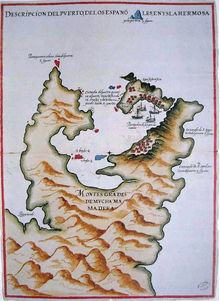
Spanish colony
The Spanish arrived in the area of Tamsui in the 17th century. In the fall of 1629, the Spanish established the first major non-aboriginal settlement comprising the town and mission of Santo Domingo. The Spanish occupied northern Taiwan for the purpose of securing Spanish interests in the Philippines against the Dutch (who were already established in the South of Taiwan by then), the British, and the Portuguese, as well as for facilitating trade with China and Japan.
In 1642, the Spanish were expelled from Taiwan by the Dutch. The Spanish had already abandoned their settlement in Tamsui in 1638 and the Dutch built a new fort which they named Fort Anthonio (after the Governor-General of the Dutch East India Company Anthonio van Diemen). It is today known as Angmo Siaa (Chinese: 紅毛城; Pe̍h-ōe-jī: Âng-mn̂g-siâⁿ; lit.: 'red-hair fortress') and is the main building of the Fort San Domingo museum complex. In addition to "pacifying" the aboriginal tribes in the area, the Dutch also encouraged the immigration and settlement of the area by Han Chinese, as well as expanding the production and trade of sulfur, animal skins, and other indigenous resources.
The Dutch left Fort Zeelandia in Taiwan in 1662 following their defeat by Koxinga at the Siege of Fort Zeelandia, who continued the policy of increasing Han Chinese immigration until the surrender of his grandson Zheng Keshuang to the Qing Dynasty in 1683. In 1668, the Dutch left Keelung after getting harassed by aboriginals from Tamsui.[15]
Qing dynasty
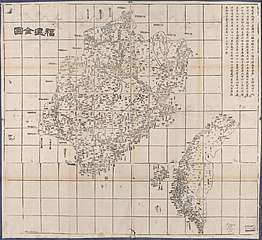
Because of its proximity to mainland China, as well as its location in a natural harbor, Tamsui quickly became a major fishing and trade port. The Qing naval patrol also established an outpost in Tamsui in 1808. In 1862, the Qing government opened Tamsui to foreign trade under the terms of the Treaty of Tientsin, exporting tea, camphor, sulfur, coal, opium, and dyes. By the mid-19th century Tamsui had become the largest port in Taiwan, boasting a sizable foreign population as well as a British consulate at Fort Santo Domingo.[16][17]
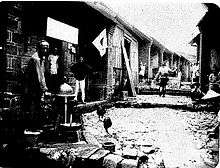
Canadian medical doctor and missionary George Leslie Mackay arrived in Tamsui on 9 March 1872, proceeding to establish Taiwan's first hospitals in Western medicine and formal educational facilities, including Oxford College (now part of Aletheia University), the oldest European-style higher-education institution in Taiwan by some measure.
During the Sino-French War the French attempted an invasion of Taiwan during the Keelung Campaign. Liu Mingchuan, who was leading the defence of Taiwan, recruited Aboriginals to serve alongside the Chinese soldiers in fighting against the French. The French were defeated at the Battle of Tamsui and the Qing forces pinned the French down at Keelung in an eight-month-long campaign before the French withdrew.
In 1884, the harbour of Tamsui was blockaded by the French Navy under the command of Admiral Amédée Courbet, during the Sino-French War.[18] The French were defeated at the Battle of Tamsui by the Chinese and, according to traditional accounts, with the divine assistance of the Goddess Mazu.
Japanese rule

By the time Taiwan was ceded to Japan following the end of the Sino-Japanese War in 1895, Tamsui's position as a seaport was beginning to wane due to the accumulation of sediments in the Tamsui River. By the 20th century, most of Tamsui's port operations had moved to Keelung, and the local economy had switched primarily to agriculture. However, public infrastructure construction projects by the Japanese led to Tamsui's rise as a local administrative and cultural center.
In the early years of Japanese rule (1895-1945), the population of the city was nearly 6,000.[19] From 1920, under the prefecture system, Tamsui was called Tamsui Town (淡水街), and was governed under Tamsui District of Taihoku Prefecture.
Post-war
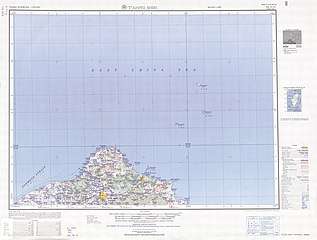
Following the end of World War II in 1945, Tamsui reverted to being a small fishing town as township of Taipei County. With the expansion of nearby Taipei City, Tamsui slowly became a center for tourism along Taiwan's northwest coast. In the last ten years, the city has become popular as a suburb of Taipei in the local real estate market.
Following the completion of the Taipei Metro's Tamsui Line in 1997, the town experienced a sharp increase in tourist traffic, reflected in the completion of several riverside parks, the growth of open-air markets specializing in traditional handicrafts and street-stall snacks, the construction of a fisherman's wharf, and the increase in passenger ferries traversing across and along the river.
Administrative divisions
Tamsui District administers forty-two urban villages (里).[20]
| Division | Chinese[20][21] | Romanization (from Tongyong Pinyin)[22][23] | Romanization (from Hanyu Pinyin)[24][23] | Romanization (from Wade–Giles) | Population (2010)[20] |
|---|---|---|---|---|---|
| Urban villages |
中和里 | Jhonghe[25] | Zhonghe[26] | Chung-ho[27] | 693 |
| 屯山里 | Tunshan | Tunshan | 1,229 | ||
| 賢孝里 | Siansiao | Xianxiao | Hsien-hsiao | 1,736 | |
| 興仁里 | Singren | Xingren | Hsing-jen | 1,749 | |
| 蕃薯里 | Fanshu | Fanshu | Fan-shu | 1,076 | |
| 義山里 | Yishan | Yishan | I-shan | 2,820 | |
| 忠山里 | Jhongshan | Zhongshan | Chung-shan | 1,026 | |
| 崁頂里 | Kanding | Kanding | K’an-ting | 2,632 | |
| 埤島里 | Pidao | Pidao | P’i-tao | 1,312 | |
| 新興里 | Sinsing | Xinxing | Hsin-hsing | 6,547 | |
| 水碓里 | Shueiduei[28] | Shuidui | Shui-tui | 6,304 | |
| 北投里 | Beitou | Beitou | Pei-t’ou | 5,779 | |
| 水源里 | Shueiyuan | Shuiyuan | Shui-yüan | 2,516 | |
| 忠寮里 | Jhongliao | Zhongliao | Chung-liao | 1,354 | |
| 樹興里 | Shusing | Shuxing | Shu-hsing | 1,165 | |
| 坪頂里 | Pingding | Pingding | P’ing-ting | 1,411 | |
| 福德里 | Fude | Fude | Fu-te | 6,574 | |
| 竹圍里 | Jhuwei | Zhuwei | Chu-wei | 6,322 | |
| 民生里 | Minsheng | Minsheng | Min-sheng | 6,774 | |
| 八勢里 | Bashih | Bashi | Pa-shih | 4,374 | |
| 竿蓁里 | Ganjhen | Ganzhen | Kan-chen | 7,890 | |
| 鄧公里 | Denggong | Denggong | 6,355 | ||
| 中興里 | Jhongsing | Zhongxing | Chung-hsing | 4,613 | |
| 長庚里 | Changgeng | Changgeng | 1,686 | ||
| 清文里 | Cingwun | Qingwen | 1,320 | ||
| 草東里 | Caodong | Caodong | 901 | ||
| 協元里 | Sieyuan | Xieyuan | 1,749 | ||
| 永吉里 | Yongji | Yongji | 1,018 | ||
| 民安里 | Min-an | Minan/Min'an | 930 | ||
| 新生里 | Sinsheng | Xinsheng | Hsin-sheng | 999 | |
| 文化里 | Wunhua | Wenhua | 2,133 | ||
| 油車里 | Youche | Youche | Yu-ch’e | 5,628 | |
| 沙崙里 | Shalun | Shalun | Sha-lun | 3,499 | |
| 新義里 | Sinyi | Xinyi | Hsin-i | 4,658 | |
| 新春里 | Sinchun | Xinchun | 6,870 | ||
| 新民里 | Sinmin | Xinmen | Hsin-min | 4,960 | |
| 正德里 | Jhengde | Zhengde | Cheng-te | 4,482 | |
| 北新里 | Beisin | Beixin | Pei-hsin | 2,907 | |
| 民權里 | Mincyuan | Minquan | Min-ch’uan/Min-ch’üan | 3,940 | |
| 幸福里 | Singfu | Xingfu | Hsing-fu | 4,742 | |
| 學府里 | Syuefu | Xuefu | 4,357 | ||
| 大庄里 | Dajhuang | Dazhuang | 4,451 |
Education
Tourist attractions
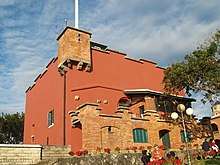
- Drop of Water Memorial Hall
- Former British Merchant Warehouse
- Fort San Domingo
- Hobe Fort
- Museum of Tamsui Fishiegoodies
- Tamsui Art Gallery
- Tamsui Church
- Tamsui Customs Officers' Residence
- Tamsui Customs Wharf
- Tamsui Fisherman's Wharf
- Tamsui Fuyou Temple
- Tamsui Historical Museum
- Tamsui Lover's Bridge
- Tamsui Lungshan Temple
- Tamsui Meteorological Observatory
- Tamsui Old Street
- Tamsui Qingshui Temple
- Tamsui Qingshui Deity's Grand Procession, on 6th day of 5th lunar month, an important fiesta for Tamsui District
- Tamsui Red Castle
- Teng Feng Fish Ball Museum
Transportation

Taipei Metro
- Tamsui Station
- Hongshulin Station
- Zhuwei Station
Light rail
Sister city

Notable natives
- Joe Hung, representative to Italy (1993-2000)
- Tu Tsung-ming, former physician
Gallery
 A French sketch of Tamsui in 1893
A French sketch of Tamsui in 1893 Tamsui Harbor/ Li Mei-shu/ 1930
Tamsui Harbor/ Li Mei-shu/ 1930 Tamsui/ Tan Ting-pho/ 1935/ 91 x 116.5 cm/ Collection from Taiwan Museum of Fine Arts
Tamsui/ Tan Ting-pho/ 1935/ 91 x 116.5 cm/ Collection from Taiwan Museum of Fine Arts Tamsui Church/ Ni Chiang-huai/ 1936/ Paper/ Watercolor/ 49.5×66 cm/ Collection of Taipei Museum of Fine Arts
Tamsui Church/ Ni Chiang-huai/ 1936/ Paper/ Watercolor/ 49.5×66 cm/ Collection of Taipei Museum of Fine Arts Tamsui waterfront at sunset
Tamsui waterfront at sunset- The sunset in front of the Long Pier of Tamsui
- The sunset in front by the Long Pier of Tamsui
Sources
- History section retrieved and translated from Tamsui District office website.
Notes
- "About Tamsui". Tamsui District Office, New Taipei City Government. Retrieved 13 July 2019.
Tamsui District
- 臺灣地區鄉鎮市區級以上行政區域名稱中英對照表 (PDF). Online Translation System of Geographic Name, Ministry of Interior. 16 June 2011. p. 1. Archived from the original (PDF) on 25 March 2012.
淡水區 Tamsui District 「淡水」依國際通用、 約定俗成方式譯寫
- Edward Stanford (1908). Atlas of the Chinese Empire (1 ed.). pp. 2, 13 – via Internet Archive.
Tamsui
{...}
Tamsui, Formosa . . 25.11 N 121.26 E - Index to Map of China (2 ed.). Shanghai: Far Eastern Geographical Establishment. 1915. p. 86 – via Internet Archive.
Tamsui ... ... ... 儋 州 [sic] Formosa ... 臺灣 ... 25.11 N 121.26 E
- Davidson (1903), p. 310.
- Davidson (1903), p. 261.
- Davidson (1903), p. 310 (illustration).
- Campbell, William (1903). "Explanatory Notes". Formosa under the Dutch: described from contemporary records, with explanatory notes and a bibliography of the island. London: Kegan Paul. p. 548. OCLC 644323041.CS1 maint: ref=harv (link)
- "Entry #824 (水)". 臺灣閩南語常用詞辭典 [Dictionary of Frequently-Used Taiwan Minnan]. (in Chinese and Hokkien). Ministry of Education, R.O.C. 2011.
- Iûⁿ, Ún-giân. 台語線頂字典 [Taiwanese Online Character Dictionary].
- Douglas, Carstairs (1899). Chinese-English dictionary of the vernacular or spoken language of Amoy (2nd ed.). London: Presbyterian church of England. p. 473. OCLC 5516636. OL 25126855M.
- Davidson (1903), p. iii: "In later chapters describing the island under Japanese rule, and in the map, the Japanese name is given first, and the Chinese in brackets, with the exception of a few well-known names such as Kelung, Takow, etc., and some English names of islands in the Pescadores." (Note: "Tansui" is not found until the index and is absent from the map)
- see, for example:
- Campbell, William (August 1896). "The island of Formosa: Its past and future". Scottish Geographical Magazine. 12 (8). map. doi:10.1080/00369229608732903.
- Davidson (1903), map
- Davidson (1903), p. 261: "The term Tamsui is used in a most liberal way; it may mean the harbor, the river, the village of Hobe, Twatutia, or Banka, and it may mean the whole district. Properly it is but the name of a river. A resident of Twatutia may likewise describe himself as a residient either of Twatutia, Taipehfu, or Tamsui, and still be quite correct so far as custom goes, although ordinarily the merchants and consuls, whether at Hobe or Twatutia, use Tamsui as their address."
- Shepherd (1993), p. 95.
- NEVILLE-HADLEY, PETER (2014). "Sleepy Tamsui Once a Thriving Treaty Port". Culture Locker. Meridian Writers’ Group.
- The consulate was closed on 13 March 1972 and returned to the authorities in 1980. See Sino-British relations.
- Elleman, Bruce A. (2001). Modern Chinese warfare, 1795-1989. Routledge. p. 89. ISBN 9780415214735.
Following this setback, the Qing court officially declared war on France on 26 August 1884. On 1 October, Admiral Courbet landed at Jilong with 2,250 men, and the city fell to the French. Chinese forces continued to encircle Jilong throughout the rest of the War. Although a French blockade thwarted all subsequent Chinese efforts to send a fleet to relieve Taiwan, the French troops never succeeded in taking the riverside town of Danshui (Tamsui) in Taiwan's northwestern coastal plain, immediately north of modern-day Taipei. As a result, French control over Taiwan was limited merely to the northern coast. China's central fleet, based in Jiangsu Province, proved unable to break through Admiral Courbet's blockade of Taiwan. Although the south quickly requested assistance from the northern fleet, Li Hongzhang refused to place his own ships in danger. This decision almost guaranteed that China's coastal waters would be dominated by the French.
- Takekoshi (1907), p. 200.
- 吳明勇 (ed.). 第壹篇 沿革志 (PDF) (in Chinese). pp. 83–84. Retrieved 12 July 2019.
附表 17:2010 年 12 月淡水鎮各里人口統計表{...}42
- 107年地方公職人員選舉 (in Chinese). Central Election Commission. Retrieved 12 July 2019.
中和里 屯山里 賢孝里 興仁里 蕃薯里 義山里 忠山里 崁頂里 埤島里 新興里 水碓里 北投里 水源里 忠寮里 樹興里 坪頂里 福德里 竹圍里 民生里 八勢里 竿蓁里 鄧公里 中興里 長庚里 清文里 草東里 協元里 永吉里 民安里 新生里 文化里 油車里 沙崙里 新義里 新春里 新民里 正德里 北新里 民權里 幸福里 學府里 大庄里
- "district+map.pdf" (PDF). Tamsui District Office, New Taipei City Government. Retrieved 12 July 2019.
[main]Tunshan Vlg. Siansiao Vlg. Jhonghe Vlg. Singren Vlg. Fanshu Vlg. Yishan Vlg. Jhongshan Vlg. Kanding Vlg. Jhongliao Vlg. Pidao Vlg. Shalun Vlg. Dajhuang Vlg. Sinchun Vlg. Shueiyuan Vlg. Beitou Vlg. Youche Vlg. Sinsing Vlg. Jhongde Vlg. Sinmin Vlg. Shueiduei Vlg. Beisin Vlg. Sinyi Vlg. Wunhua Vlg. Jhongsing Vlg. Syuefu Vlg. Shusing Vlg. Denggong Vlg. Sinfu[sic] Vlg. Ganjhen Vlg. Pingding Vlg. Bashih Vlg. Minsheng Vlg. Jhuwei Vlg. Mingcyuan Vlg. Fude Vlg. [inset] Wunhua Vlg. Sieyuan Vlg. Sinsheng Vlg. Yongji Vlg. Cingwun Vlg. Sinfu Vlg.[mislabeled; should be 'Changgeng Vlg.'] Min-an Vlg. Caodong Vlg. Sinfu[sic] Vlg.
(note that the transcription of the map is approximate; the map also includes some blatant errors) - "Map of Administrative Districts". Tamsui District Office, New Taipei City Government. Retrieved 12 July 2019.
Tamsui Include Tunshan Vlg. Jhonghe Vlg. Siansiao Vlg. Fansh[sic] Vlg.Singren Vlg. Yishan Vlg. Jhongshan Vlg. Kanding Vlg. Pidao Vlg.Jhongliao Vlg.Shueiyuan Vlg. Beitou Vlg. Shalun Vlg.Dazhung[sic] Vlg.Youche Vlg. Xinchun Vlg. Xinxing Vlg. Xinmin Vlg. Wenhua Vlg. Zhengde Vlg.Shuidui Vlg. Xinyi Vlg. Beixin Vlg. Jhongsing Vlg. Syuefu Vlg. Denggog[sic] Vlg. Sinfu Vlg. Shusing Vlg. Ganjhen Vlg. Xleyuan[sic] Vlg. Xinsheng Vlg. Uongli[sic] Vlg. Min-an Vlg. Cingwen Vlg. Changgeng Vlg. Caodong Vlg. pingding[sic] Vlg. Bashih Vlg. Minsheng Vlg. Jhuwei Vlg. Minocyuan[sic] Vlg. Fude Vlg.
(note that the list includes some blatant errors) - "2018 Local Elections". Central Election Commission. Retrieved 12 July 2019.
Zhonghe Vil. Tunshan Vil. Xianxiao Vil. Xingren Vil. Fanshu Vil. Yishan Vil. Zhongshan Vil. Kanding Vil. Beidao Vil. Xinxing Vil. Shuidui Vil. Beitou Vil. Shuiyuan Vil. Zhongliao Vil. Shuxing Vil. Pingding Vil. Fude Vil. Zhuwei Vil. Minsheng Vil. Bashi Vil. Ganzhen Vil. Denggong Vil. Zhongxing Vil. Zhanggeng[sic] Vil. Qingwen Vil. Caotung[sic] Vil. Xieyuan Vil. Yongji Vil. Minan Vil. Xinsheng Vil. Wenhua Vil. Youju[sic] Vil. Shalun Vil. Xinyi Vil. Xinchun Vil. Xinmin Vil. Zhengde Vil. Beixin Vil. Minquan Vil. Xingfu Vil. Xuefu Vil. Dazhuang Vil.
(note that the list includes some blatant errors) - Jhonghe (Variant - V) at GEOnet Names Server, United States National Geospatial-Intelligence Agency
- Zhonghe (Approved - N) at GEOnet Names Server, United States National Geospatial-Intelligence Agency
- Chung-ho (Variant - V) at GEOnet Names Server, United States National Geospatial-Intelligence Agency
- "Police Station". Retrieved 12 July 2019.
Shueiduei
- Guo, Elizabeth; Kennedy, Brian (10 July 2008). "Tale of two towns : Chico, Calif., and Tamsui, Taiwan, Republic of China, have more in common than you might think". Chico News & Review. Retrieved 28 December 2014.
Bibliography
- Davidson, James W. (1903). The Island of Formosa, Past and Present : history, people, resources, and commercial prospects : tea, camphor, sugar, gold, coal, sulphur, economical plants, and other productions. London and New York: Macmillan. OCLC 1887893. OL 6931635M.CS1 maint: ref=harv (link)
- Takekoshi, Yosaburō (1907). Japanese rule in Formosa. London, New York, Bombay and Calcutta: Longmans, Green, and co. OCLC 753129. OL 6986981M.CS1 maint: ref=harv (link)
External links
| Wikimedia Commons has media related to Tamsui. |

- Tamsui Historic Museum
- Why Tamsui people are called Tamsuian?
- Takao Club: The Tamsui Foreign Cemetery
- Tamsui Travel Guide